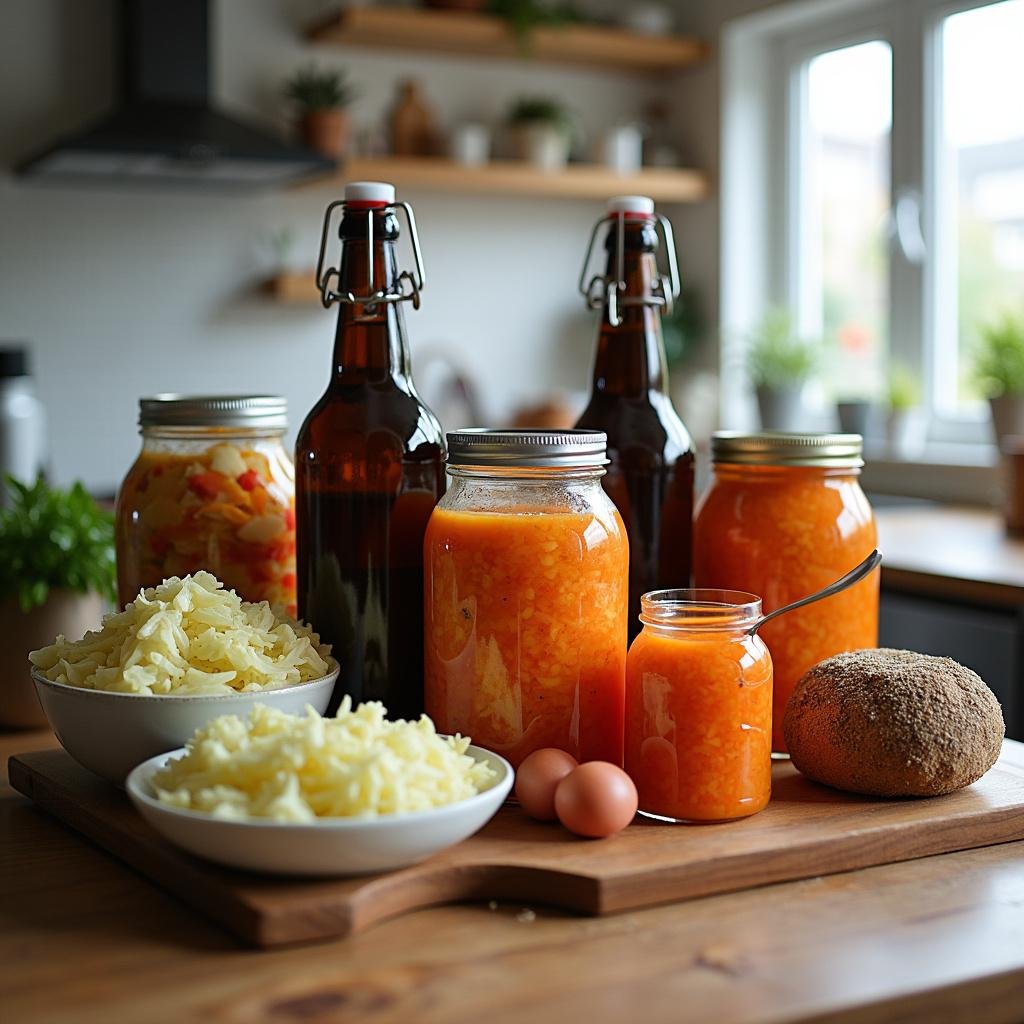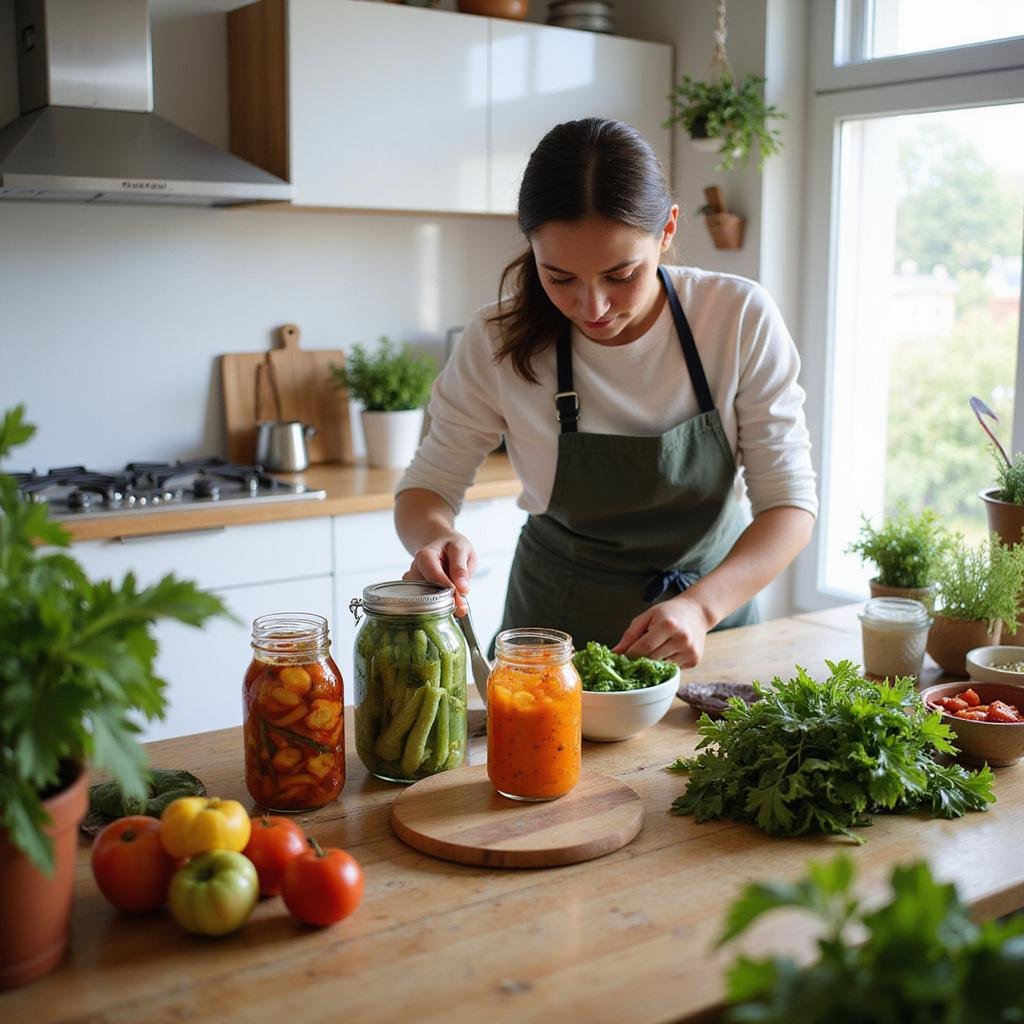1. Introduction
Fermented foods have soared in popularity in recent years, valued not only for their unique flavors but also for their impressive health benefits. Learning how to make easy fermented foods you can make at home is a cost-effective and enjoyable way to incorporate probiotics into your diet. Whether you’re just starting or have some fermentation experience, this comprehensive guide will introduce you to the best kw and simple recipes for creating delicious, nutritious fermented snacks and drinks right in your kitchen. From tangy sauerkraut to revitalizing kombucha, discover how to seamlessly add these foods into your daily routine and improve your gut health naturally.
2. Why Choose Fermented Foods You Can Make at Home
Opting for easy fermented foods you can make at home allows you to enjoy superior freshness, personalized flavors, and avoids unnecessary preservatives often found in store-bought options. Homemade fermentation also gives you control over ingredients, ensuring your food is free from artificial additives and excess sugars. As a bonus, engaging in home fermentation is straightforward—requiring minimal equipment and time—making it accessible for anyone intrigued by a healthier lifestyle. To get started with essential tools, consider investing in a Ninja SLUSHi with RapidChill Technology to create instant, chilled fermented drinks, or a Fullstar Vegetable Chopper and Spiralizer to prep vegetables quickly and efficiently for fermentation.

3. Top 5 Easy Fermented Foods You Can Make at Home
Venturing into home fermentation is simpler than many assume. Here are the best kw five options that anyone can try for easy fermented foods you can make at home:
Sauerkraut
Sauerkraut remains a favorite for its probiotic properties and tangy flavor. This fermented cabbage dish is budget-friendly, simple to prepare, and fits perfectly into sandwiches, salads, or as a side dish. To make harmonious batches, shred fresh cabbage, add sea salt, and allow it to ferment in a jar for 1-4 weeks, customizing the acidity level to your liking. For a seamless process, use a KitchenAid Classic Series Stand Mixer to shred vegetables efficiently before salting and fermenting.
Kimchi
This spicy Korean fermented vegetable delight, typically made with Napa cabbage, radishes, and seasonings, packs a punch of flavor and nutrients. Though it requires some preparation, fermenting kimchi produces a flavorful condiment that enhances any meal. Incorporate a Ninja Air Fryer Pro to prepare ingredients quickly, and let the fermentation work its magic over 1-2 weeks at room temperature, then store in airtight containers like the JoyJolt Glass Storage Containers for freshness.
Kombucha
Fermented tea, or kombucha, is a lively, effervescent beverage loaded with beneficial probiotics. Brewing kombucha at home requires fermenting sweetened tea with a SCOBY, a symbiotic culture of bacteria and yeast. To streamline your process, you can use a Ninja Blender to prepare the tea base, and a durable jar or fermentation vessel. Flavor your kombucha with fruits and herbs for variety, and maintain proper fermentation times to achieve the desired fizz and tang.
Yogurt
Store-bought yogurt is convenient, but homemade yogurt offers unmatched freshness and probiotic benefits. Simple to make with milk and a starter culture, you can use a Cuisinart Bread Maker to maintain consistent incubation temperature or opt for a yogurt maker. Incubate the mixture at 110°F for 6-12 hours until it reaches a creamy, tangy finish. This process ensures a healthy, customizable probiotic source for your diet.
Fermented Vegetables
Beyond cabbage, vegetables like carrots, turnips, and beets are fantastic candidates for fermentation, providing vital enzymes and probiotics. Experimenting with different produce adds variety and health benefits. To prep, slice vegetables with a Fullstar Vegetable Chopper and Spiralizer for uniform pieces, and ferment in glass jars with proper salt levels. These colorful pickles make a nutritious addition to any meal.
4. How to Start Making Fermented Foods at Home
Getting started with fermentation is straightforward. With a few essential tools and ingredients, you can produce best kw quality fermented foods. Begin by sterilizing jars and utensils—consider an intensive cleaning with Ninja SLUSHi with RapidChill Technology for quick chilling of probiotic drinks. Use fresh produce for optimal fermentation, and follow recommended fermentation times, adjusting based on flavor preferences and ambient temperature. Don’t forget to use the right amount of salt to facilitate proper fermentation and flavor development, similar to how you would with a KitchenAid Stand Mixer to process ingredients efficiently.
5. Tips and Tricks for Successful Fermentation
- Maintain Consistent Temperature: Keep your fermenting foods at approximately 65-75°F (18-24°C). To improve your setup, consider a Fermentation Chamber or Insulated Box for temperature stability.
- Ensure All Vegetables are Submerged: Use fermentation weights like the KitchenAid Stand Mixer attachments or weights to keep everything under the brine, preventing mold.
- Patience is Crucial: Tasting your ferments periodically helps you find the perfect flavor profile. For quick results, you might use a RapidChill Technology-based device for rapid cooling after fermentation.
- Label Your Jars: Use grain-free or themed labels on your jars—think about a Clever Fox Recipe Book Spiral to track recipes and fermentation dates.
6. FAQs About Making Easy Fermented Foods at Home
Q: Are homemade fermented foods safe to consume?
A: Absolutely, as long as proper hygiene and fermentation protocols are followed. Always inspect for mold, foul odors, or discolored textures before consuming. Using quality containers like the glass storage containers helps maintain safety and freshness.
Q: How long does it typically take to ferment foods like sauerkraut or kimchi?
A: Sauerkraut generally ferments for 1-4 weeks, while kimchi can be ready in 1-2 weeks, depending on temperature and flavor intensity desired. Patience pays off for nutrient-rich results.
Q: Can I flavor my fermented foods?
A: Yes! Adding herbs, spices, or fruits during fermentation can create personalized flavors. Fresh herbs from a KitchenAid Stand Mixer facilitate blending ingredients smoothly.
Q: What is the best container for fermentation?
A: Glass jars with airtight lids are ideal because they are non-reactive, easy to sterilize, and convenient for monitoring fermentation progress. Consider trying glass storage containers for optimal results.
7. Conclusion
Mastering home fermentation opens a world of nutritious and flavorful possibilities. Creating easy fermented foods you can make at home allows you to enjoy health-boosting probiotics like sauerkraut, kimchi, kombucha, yogurt, and other fermented vegetables effortlessly. With the right tools, patience, and basic knowledge, you’ll soon be savoring probiotics-rich foods that support digestion, boost immunity, and elevate your culinary skills. Take the first step today by exploring simple recipes, leveraging quality equipment, and embracing the natural art of fermentation. Your health and taste buds will thank you!

